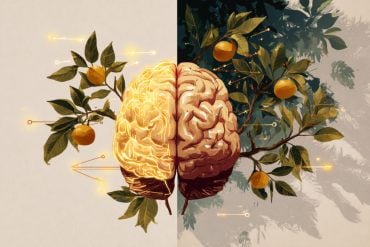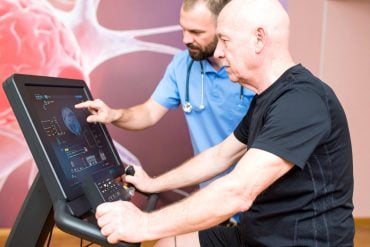Summary: Chronic alcohol consumption can increase sensitivity to pain through two molecular mechanisms. Researchers also identified potential new drug targets for treating alcohol-related chronic pain. Over half of people with alcohol use disorder (AUD) suffer from persistent pain, including alcoholic neuropathy. The study found that alcohol withdrawal could result in neuropathy that was not reversed by re-exposure to alcohol.
Source: Scripps Research Institute
Chronic alcohol consumption may make people more sensitive to pain through two different molecular mechanisms—one driven by alcohol intake and one by alcohol withdrawal. That is one new conclusion by scientists at Scripps Research on the complex links between alcohol and pain.
The research, published in the British Journal of Pharmacology on April 12, 2023, also suggests potential new drug targets for treating alcohol-associated chronic pain and hypersensitivity.
“There is an urgent need to better understand the two-way street between chronic pain and alcohol dependence,” says senior author Marisa Roberto, PhD, the Schimmel Family Chair of Molecular Medicine, and a professor of neuroscience at Scripps Research. “Pain is both a widespread symptom in patients suffering from alcohol dependence, as well as a reason why people are driven to drink again.”
Alcohol use disorder (AUD), which encompasses the conditions commonly called alcohol abuse, alcohol dependence and alcohol addiction, affects 29.5 million people in the U.S. according to the 2021 National Survey on Drug Use and Health. Over time, AUD can trigger the development of numerous chronic diseases, including heart disease, stroke, liver disease and some cancers.
Among the many impacts of long-term alcohol consumption is pain: more than half of people with AUD experience persistent pain of some type. This includes alcoholic neuropathy, which is nerve damage that causes chronic pain and other symptoms.
Studies have also found that AUD is associated with changes in how the brain processes pain signals, as well as changes to how immune system activation occurs. In turn, this pain can lead to increased alcohol consumption. Moreover, during withdrawal, people with AUD can experience allodynia, in which a harmless stimulus is perceived as painful.
Roberto and her colleagues were interested in learning the underlying causes of these different types of alcohol-related pain. In the new study, they compared three groups of adult mice: animals that were dependent on alcohol (excessive drinkers), animals that had limited access to alcohol and were not considered dependent (moderate drinkers), and those that had never been given alcohol.
In dependent mice, allodynia developed during alcohol withdrawal, and subsequent alcohol access significantly decreased pain sensitivity. Separately, about half of the mice that were not dependent on alcohol also showed signs of increased pain sensitivity during alcohol withdrawal but, unlike the dependent mice, this neuropathy was not reversed by re-exposure to alcohol.

When Roberto’s group then measured levels of inflammatory proteins in the animals, they discovered that while inflammation pathways were elevated in both dependent and non-dependent animals, specific molecules were only increased in dependent mice. This indicates that different molecular mechanisms may drive the two types of pain. It also suggests which inflammatory proteins may be useful as drug targets to combat alcohol-related pain.
“These two types of pain vary greatly, which is why it is important to be able to distinguish between them and develop different ways to treat each type,” says first author Vittoria Borgonetti, PhD, a postdoctoral associate at Scripps Research.
Roberto’s group is continuing studies on how these molecules might be used to diagnose or treat alcohol-related chronic pain conditions.
“Our goal is to unveil new potential molecular targets that can be used to distinguish these types of pain and potentially be used in the future for the development of therapies,” says co-senior author Nicoletta Galeotti, PhD, associate professor of preclinical pharmacology at the University of Florence.
In addition to Roberto, authors of the study, “Chronic alcohol induced mechanical allodynia by promoting neuroinflammation: a predictive mice model of alcoholic neuropathy,” include Amanda Roberts, Michal Bajo and Vittoria Borgonetti of Scripps Research; and Nicoletta Galeotti of University of Florence.
Funding: This work was supported by funding from the National Institutes of Health (The Integrative Neuroscience Initiative on Alcoholism Consortium AA013498, AA027700, AA021491, AA017447, AA006420, and AA029841), The Schimmel Family Chair, The Pearson Center for Alcoholism and Addiction Research, and The Scripps Research Institute’s Animal Models Core Facility.
About this pain and alcohol addiction research news
Author: Press Office
Source: Scripps Research Institute
Contact: Press Office – Scripps Research Institute
Image: The image is in the public domain
Original Research: Closed access.
“Chronic alcohol induced mechanical allodynia by promoting neuroinflammation: a predictive mice model of alcoholic neuropathy” by Marisa Roberto et al. British Journal of Pharmacology
Abstract
Chronic alcohol induced mechanical allodynia by promoting neuroinflammation: a predictive mice model of alcoholic neuropathy
Background and Purpose
Unrelieved chronic pain is considered a key factor contributing to the maintenance of alcohol use disorder (AUD). The mechanisms responsible for chronic pain associated with chronic alcohol consumption are still unknown. Thus, our goal was to evaluate the development of chronic pain in a mouse model of alcohol dependence and investigate the role of neuroinflammation in this chronic condition.
Experimental Approach
We used the chronic-intermittent ethanol two-bottle choice CIE-2BC paradigm that generates three groups: (1) alcohol-dependent mice that exhibit escalating alcohol intake, (2) nondependent mice, mimicking moderate drinking, that experience voluntary drinking, and (3) alcohol-naïve control male and female mice. We measured mechanical allodynia using von Frey filaments during withdrawal and after the last voluntary drinking. Finally, we used immunoblotting to evaluate the protein levels of ionized calcium-binding adapter molecule-1 (IBA-1), macrophage-colony stimulating factor (CSF-1), interleukin 6 (IL-6), p38 and extracellular signal-regulated kinase 1/2 (ERK44/42) in spinal cord tissue of dependent and non-dependent animals.
Key Results
We found significant escalation of drinking in the dependent group in male and female compared with the non-dependent group. The dependent group developed strong mechanical allodynia during 72 h of withdrawal, which was completely reversed immediately after the voluntary drinking. Moreover, we observed an increased pain hypersensitivity (allodynia) compared with the naïve group in 40% and 50% of non-dependent male and female mice, respectively. Increased IBA-1 and CSF-1 expression was observed in spinal cord tissue of both hypersensitivity-abstinence related and neuropathy-alcohol mice, and increased IL-6 expression and ERK44/42 activation in mice with hypersensitivity-related to abstinence, but not in mice with alcohol-evoked neuropathic pain.
Conclusions and Implications
We showed that the CIE-2BC model induces two distinct pain conditions specific to the type of ethanol exposure: abstinence-related hypersensitivity in dependent mice and alcohol-evoked neuropathic pain in about a half of the non-dependent mice.







